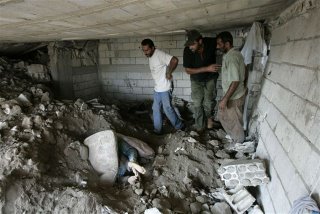 In this second scene of Act 3, the central player becomes "White Tee-shirt", a brooding, enigmatic figure, also described as a "local resident" and in some photograph captions as a "rescuer". But, in the same way that we do not see "White Helmet" doing any digging, neither do we see "White Tee-shirt" doing any rescuing.
In this second scene of Act 3, the central player becomes "White Tee-shirt", a brooding, enigmatic figure, also described as a "local resident" and in some photograph captions as a "rescuer". But, in the same way that we do not see "White Helmet" doing any digging, neither do we see "White Tee-shirt" doing any rescuing. The cameras catch him around the site occasionally, but there is no hint from the poses that he is much more than an interested by-stander, although he seems to have unprecedented access to the wreckage. He is clearly a man of some standing, as his right of access does not seem to be challenged, even though he is not in uniform and has no apparent formal role in the rescue.
The cameras catch him around the site occasionally, but there is no hint from the poses that he is much more than an interested by-stander, although he seems to have unprecedented access to the wreckage. He is clearly a man of some standing, as his right of access does not seem to be challenged, even though he is not in uniform and has no apparent formal role in the rescue. 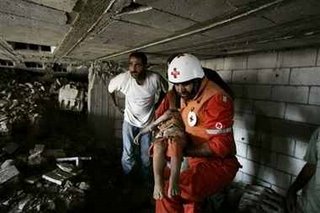 Here he is again, this time inside the wreckage and again he is not actually doing anything but watching. But it seems he is doing more than that. We get the distinct impression he is looking for particular bodies. The one in the arms of the Red Cross worker, the body of the "girl in orange" is not one of them. Mr "White Tee-shirt" takes no interest in it and shows no emotion.
Here he is again, this time inside the wreckage and again he is not actually doing anything but watching. But it seems he is doing more than that. We get the distinct impression he is looking for particular bodies. The one in the arms of the Red Cross worker, the body of the "girl in orange" is not one of them. Mr "White Tee-shirt" takes no interest in it and shows no emotion.A rehearsal?
 However, there is certainly a hint of his star quality in what could well have been a rehearsal for the main scene. This starts, as does the main scene, at the staging area. Centre of the frame (left), sitting - rather uncomfortably it seems - on a gurney (or litter), is a middle-aged, male "survivor" of the bombing raid - that, at least, is the assumption. No one is paying much attention to him and his wounds (or wound, evidenced by the blood stain on his shirt, on his left shoulder) have not been attended to.
However, there is certainly a hint of his star quality in what could well have been a rehearsal for the main scene. This starts, as does the main scene, at the staging area. Centre of the frame (left), sitting - rather uncomfortably it seems - on a gurney (or litter), is a middle-aged, male "survivor" of the bombing raid - that, at least, is the assumption. No one is paying much attention to him and his wounds (or wound, evidenced by the blood stain on his shirt, on his left shoulder) have not been attended to. Here (left), we see the same man, now all but lying down on the padded litter. But this time he is being transported by three stretcher bearers - two in front and one at the rear. We know from previous frames that this is some way down from the staging area, just before "Stretcher corner". Note the tee-shirt of the front-left (as we view him) stretcher bearer and, just visible behind the group, the helmet of a Red Cross Worker.
Here (left), we see the same man, now all but lying down on the padded litter. But this time he is being transported by three stretcher bearers - two in front and one at the rear. We know from previous frames that this is some way down from the staging area, just before "Stretcher corner". Note the tee-shirt of the front-left (as we view him) stretcher bearer and, just visible behind the group, the helmet of a Red Cross Worker.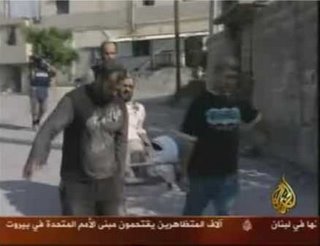 From Aljazeera footage, we see exactly the same trio, further down the route, just short of "Stretcher Corner" (see satellite image). This time they are being followed by another video camera operator, recording their progress. The patient is almost sitting up and he is certainly taking a keen interest in proceedings. One wonders quite how injured he really is especially as, even now, he has had no obvious medical treatment.
From Aljazeera footage, we see exactly the same trio, further down the route, just short of "Stretcher Corner" (see satellite image). This time they are being followed by another video camera operator, recording their progress. The patient is almost sitting up and he is certainly taking a keen interest in proceedings. One wonders quite how injured he really is especially as, even now, he has had no obvious medical treatment. Now, however, we have the stretcher party emerging from "Stretcher Corner", turning to walk up the rise, over the debris. The backdrop is unfamiliar as the photographer seems to be virtually at the corner, shooting at a roughly 45-degree angle to the line of the Alley, catching the buildings seen at the lower end.
Now, however, we have the stretcher party emerging from "Stretcher Corner", turning to walk up the rise, over the debris. The backdrop is unfamiliar as the photographer seems to be virtually at the corner, shooting at a roughly 45-degree angle to the line of the Alley, catching the buildings seen at the lower end.Crucially, there are now four and not three bearers, although the addition is not the Red Cross worker that we saw in the first of this sequence of frames. It is "Green Helmet" sharing the load. It could of course be argued that he was simply lending a hand as the the ground got rougher.
 That would be a simple enough explanation except that, around "Stretcher Corner", we know the road is fairly clear (see right). The party is deliberately taking the corner wide, on to the debris field alongside the road, to make for a more dramatic shot - and the photographer, AFP's Nicolas Asfouri, could hardly have avoided knowing that they were faking it. But he went along with it and issued the photograph, adding a false caption that read, in part:
That would be a simple enough explanation except that, around "Stretcher Corner", we know the road is fairly clear (see right). The party is deliberately taking the corner wide, on to the debris field alongside the road, to make for a more dramatic shot - and the photographer, AFP's Nicolas Asfouri, could hardly have avoided knowing that they were faking it. But he went along with it and issued the photograph, adding a false caption that read, in part:Rescuers carry a wounded man out of the rubble of a house after Israeli air strikes on the southern Lebanese village of Qana 30 July 2006…And even that was not the end of the deception.
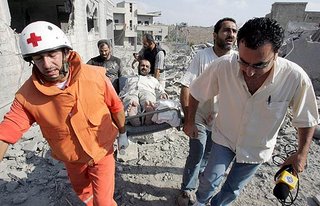 In this view, we see the same "survivor" on the same litter, but this scene is being played out further up "Stretcher Alley" in full view of the media scrum. Replacing the front two stretcher bearers are a more photogenic Red Cross worker and "White Tee-shirt" (behind the reporter). Note that the bearer formerly at the front-left has been "demoted" to the rear. This is the third combination in less than 100 yards and, unless there were two separate runs, the switch must have happened in full view of the media. Now look at the expression on the face of "White Tee-shirt". We will see something like this again.
In this view, we see the same "survivor" on the same litter, but this scene is being played out further up "Stretcher Alley" in full view of the media scrum. Replacing the front two stretcher bearers are a more photogenic Red Cross worker and "White Tee-shirt" (behind the reporter). Note that the bearer formerly at the front-left has been "demoted" to the rear. This is the third combination in less than 100 yards and, unless there were two separate runs, the switch must have happened in full view of the media. Now look at the expression on the face of "White Tee-shirt". We will see something like this again.The run begins
 Rehearsals apart, courtesy of Al Manar television we now have a complete record of the first stage of "White Tee-shirt's" camera run - continuous footage which opens with "Green Helmet" starting off with "Blue pants". In the frame here, we see "White Tee-shirt", slightly left of centre, being called by the bearded man in the white shirt, who is holding "Pink pyjamas". "White Tee-shirt" is beginning to turn in response to the call.
Rehearsals apart, courtesy of Al Manar television we now have a complete record of the first stage of "White Tee-shirt's" camera run - continuous footage which opens with "Green Helmet" starting off with "Blue pants". In the frame here, we see "White Tee-shirt", slightly left of centre, being called by the bearded man in the white shirt, who is holding "Pink pyjamas". "White Tee-shirt" is beginning to turn in response to the call. In this frame we now see the start of the hand-over, filmed not only by the camera through which lens we are looking, but also by the camera on the left, just visible in the frame.
In this frame we now see the start of the hand-over, filmed not only by the camera through which lens we are looking, but also by the camera on the left, just visible in the frame.Possibly of significance, we can just see to the right of the frame, what looks to be the body of yet another child. Is this part of the "stock" held by the bearded man, ready to issue to his band of thespians?
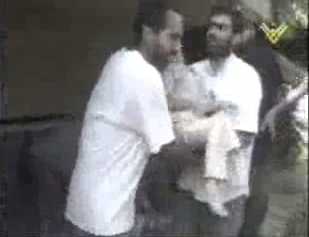 Anyhow, it is the turn of "Pink pyjamas" for the spotlight and in this frame the hand-over is nearly complete.
Anyhow, it is the turn of "Pink pyjamas" for the spotlight and in this frame the hand-over is nearly complete.This may be the shot in which the bearded man is caught on film emoting, but it is not yet the turn of "White Tee-shirt" to do likewise. Despite the blurring, we can see that his expression, at the moment, is relatively neutral as he concentrates on the task at hand.
 And now we see "White Tee-shirt", in full possession of the child's body, turning away to step out into the road where other cameras are waiting. This is the start of his own camera run.
And now we see "White Tee-shirt", in full possession of the child's body, turning away to step out into the road where other cameras are waiting. This is the start of his own camera run.Once again though - even despite the poor quality of the picture - we can see that his expression still is relatively neutral. There is no great display of emotion.
 Here, with "White Tee-shirt" a few yards into his run, the full vista opens up. He has cameras to the front, side and rear, with what looks like a "minder" signalling to the cameras the direction "White Tee-shirt" will take. This is clearly an arranged "shoot" with the cameras pre-positioned to take the shots as the subject appears. There cannot possibly be anything spontaneous about this.
Here, with "White Tee-shirt" a few yards into his run, the full vista opens up. He has cameras to the front, side and rear, with what looks like a "minder" signalling to the cameras the direction "White Tee-shirt" will take. This is clearly an arranged "shoot" with the cameras pre-positioned to take the shots as the subject appears. There cannot possibly be anything spontaneous about this. The above was from France 2, but from a different source, taken directly from the website. Here, "White Tee-shirt" is now flanked by his minder, who has moved to the left to allow the still photographer a clear shot. You can now see the beginnings of an emotive expression developing on "White Tee-shirt's" face as he gets into his stride. Partly discernible from his pose, but clearly evident in the video footage, he is walking extremely fast, just short of a full run.
The above was from France 2, but from a different source, taken directly from the website. Here, "White Tee-shirt" is now flanked by his minder, who has moved to the left to allow the still photographer a clear shot. You can now see the beginnings of an emotive expression developing on "White Tee-shirt's" face as he gets into his stride. Partly discernible from his pose, but clearly evident in the video footage, he is walking extremely fast, just short of a full run. A few strides on and now "White Tee-shirt" is assuming an anguished expression. This intensifies with every stride. His mouth opens and he starts to shout passionately, as he steps onwards, his swiftening stride conveying a sense of urgency. Yet, the urgency is false, part of the act that he is putting on for the benefit of the media. There is nothing urgent here. The child is dead and the progress of its body to the ambulance has already been delayed to allow the photo-shoot to be set up.
A few strides on and now "White Tee-shirt" is assuming an anguished expression. This intensifies with every stride. His mouth opens and he starts to shout passionately, as he steps onwards, his swiftening stride conveying a sense of urgency. Yet, the urgency is false, part of the act that he is putting on for the benefit of the media. There is nothing urgent here. The child is dead and the progress of its body to the ambulance has already been delayed to allow the photo-shoot to be set up.  Well into his stride now and emoting freely, a few yards on from the staging area, "White Tee-shirt" is producing iconic material, captured by Zohra Bensemra of Reuters/Corbis, who describes "White Tee-shirt" as a "Lebanese volunteer". This picture makes the Daily Telegraph website and many other dailies. Again, the combination of the photogenic corpse and the "raw emotion" make the picture irresistible. It is a bravura performance, even if the result lacks the essential touch of the background wreckage.
Well into his stride now and emoting freely, a few yards on from the staging area, "White Tee-shirt" is producing iconic material, captured by Zohra Bensemra of Reuters/Corbis, who describes "White Tee-shirt" as a "Lebanese volunteer". This picture makes the Daily Telegraph website and many other dailies. Again, the combination of the photogenic corpse and the "raw emotion" make the picture irresistible. It is a bravura performance, even if the result lacks the essential touch of the background wreckage. Round the bend he goes, losing sight of the staging area. Aljazeera television now picks up the run, "White Tee-shirt" emoting less freely. He is met by another posse of photographers, ready and waiting to grab action pictures. He has only a few dozen yards to go now, with the Aljazeera cameraman still in attendance, before he reaches "Stretcher Corner" where he will perform his last leg of the run.
Round the bend he goes, losing sight of the staging area. Aljazeera television now picks up the run, "White Tee-shirt" emoting less freely. He is met by another posse of photographers, ready and waiting to grab action pictures. He has only a few dozen yards to go now, with the Aljazeera cameraman still in attendance, before he reaches "Stretcher Corner" where he will perform his last leg of the run. And here he is actually at "Stretcher Corner" with yet more photographers waiting to capture their shots.
And here he is actually at "Stretcher Corner" with yet more photographers waiting to capture their shots.The wreckage-strewn rise of "Stretcher Alley" can be seen to the left of the frame and it is up this rise where "White Tee-shirt" will deliver his most memorable performance, a performance which will get his image on the front pages of newspapers throughout the world.
 Round the corner, this is what is waiting for him - a scrum of press photographers, ready and waiting to catch the show. In this video "grab", their interest is taken by Red Cross workers carrying a stretcher, but this is precisely the position from which they will also capture "White Tee-shirt's" performance.
Round the corner, this is what is waiting for him - a scrum of press photographers, ready and waiting to catch the show. In this video "grab", their interest is taken by Red Cross workers carrying a stretcher, but this is precisely the position from which they will also capture "White Tee-shirt's" performance. And he is about to give the performance of a lifetime - a heart-wrenching display of raw emotion.
A problem
In earlier analyses, our narrative assumed that, of the two camera runs, "Green Helmet" started off first - which indeed he does - and there was then some delay before "White Tee-shirt" set out. What the Al Manar footage shows, however, is that the delay is only a matter of seconds. Furthermore, while "Green Helmet" sets off at a fairly sedate pace, "White Tee-shirt" is all but running.
Given the relative speeds of the two men, and the distance from the staging area to "Stretcher Corner", it seems inconceivable that "White Tee-shirt" had not caught up by then. Yet, as we know, "Green Helmet" is able to do a solo run, up "Stretcher Alley". Not only that, as we see in Scene 1, he deposits his load on the gurney, turns round and goes back to meet "White Tee-shirt", whence they perform a duet, running together for the last part of the second camera run. The timings thus seem to be wrong.
We have no photographic or other evidence to suggest what might have happened, but it seems reasonable to speculate that, at some point, "White Tee-shirt" paused to allow his partner to complete his phase of the run. But we have near-continuous video coverage of "White Tee-shirt" from the moment he leaves the staging area to the point where he arrives at "Stretcher Corner", and there is no record of him pausing along this route.
Whatever happens, therefore, also happens in full view of the media. However, what is interesting is that, while we do have this continuous video coverage of the first leg of the run, the record stops at the corner. So far, no video footage has emerged for either "Green Helmet" or "White Tee-shirt" progressing up the slope. The record in this section is captured entirely by still photographers. This is curious and may be significant. Would video footage have shown the extent of the staging?
The second leg
 Continuing with his journey, in a picture from AP's Nasser Nasser, we now see "White Tee-shirt" making his solo debut up "Stretcher Alley". As far as is evident, he is on his own, with no sign of "Green Helmet". He makes an appearance shortly, having completed his delivery to the gurney at the top of the rise.
Continuing with his journey, in a picture from AP's Nasser Nasser, we now see "White Tee-shirt" making his solo debut up "Stretcher Alley". As far as is evident, he is on his own, with no sign of "Green Helmet". He makes an appearance shortly, having completed his delivery to the gurney at the top of the rise.The snappers are doing their business here, but "White Tee-shirt" has not yet been able to replicate the performance he gave in the first leg. His stride is too purposeful. He looks soulful but his head hangs and there is no passion or drama in the pose. The rubble is bit too messy and amorphous and there is nothing to draw the eye to add contrast to the lonely figure marching up the litter-strewn slope. As a picture, this simply doesn't gel.
 Whether he was truly by himself in the above shot is difficult to judge, but there is some confirmation from this, the photograph used on the front page of The Daily Telegraph. The same picture is also used by The Daily Mail on its front page and its website, the caption here inexplicably reading: "A father carries a little girl from the ruins of Qana".
Whether he was truly by himself in the above shot is difficult to judge, but there is some confirmation from this, the photograph used on the front page of The Daily Telegraph. The same picture is also used by The Daily Mail on its front page and its website, the caption here inexplicably reading: "A father carries a little girl from the ruins of Qana".Attributed to Lafargue Frederic of the Gamma agency, this picture again shows "White Tee-shirt" on a solo run, with no sign of "Green Helmet". We can assume that "White Tee-shirt" is most likely on his own. But this is the last shot we see him like this.
 By now, "Green Helmet" has got in position for a dual shot, although from this angle you can only just see the crown of his helmet over "Tee-shirt's" left shoulder. He must either have been waiting for his partner to catch up, or he has rushed down to meet him.
By now, "Green Helmet" has got in position for a dual shot, although from this angle you can only just see the crown of his helmet over "Tee-shirt's" left shoulder. He must either have been waiting for his partner to catch up, or he has rushed down to meet him.As to "White Tee-shirt", his pose is now magnificant - the head thrown back in anguish, the body clutched to the bosom and the soulful expression all combine to give just the note that is needed. Many editors find this is just right and rush to print it.
 Perhaps in this one, "White Tee-shirt" is overdoing it slightly, but it isn't a lot different from the previous frame. What really spoils it is "Green Helmet" peering round "Tee-shirt's" shoulder, as he strides along to catch up with is co-star in order to take an equal role in the drama. But his presence at such an awkward angle breaks up the symmetry of the pose and creates a distraction. Nevertheless, Nicolas Asfouri for AFP-Getty Images labels the picture, "A man screams for help as he carries the body of a girl killed in the Israeli strike on Qana on July 30". It gets used by Newsweek, amongst others.
Perhaps in this one, "White Tee-shirt" is overdoing it slightly, but it isn't a lot different from the previous frame. What really spoils it is "Green Helmet" peering round "Tee-shirt's" shoulder, as he strides along to catch up with is co-star in order to take an equal role in the drama. But his presence at such an awkward angle breaks up the symmetry of the pose and creates a distraction. Nevertheless, Nicolas Asfouri for AFP-Getty Images labels the picture, "A man screams for help as he carries the body of a girl killed in the Israeli strike on Qana on July 30". It gets used by Newsweek, amongst others. As a dual shot, this next one is unusable. Look closely at "Green Helmet" and - although he most certainly isn't - he appears to be smirking. The combination of the exertion and trying to present the appropriate gravitas is proving too much for the man. But, if the effect is grotesque, "Tee-shirt" is delivering. So out come the scissors (or the crop button) and "Green Helmet" is history. The result is perfect for the front page of The Independent.
As a dual shot, this next one is unusable. Look closely at "Green Helmet" and - although he most certainly isn't - he appears to be smirking. The combination of the exertion and trying to present the appropriate gravitas is proving too much for the man. But, if the effect is grotesque, "Tee-shirt" is delivering. So out come the scissors (or the crop button) and "Green Helmet" is history. The result is perfect for the front page of The Independent. But everything is coming right. Without moving from their positions, all the snappers have to do is let the stars come to them. Now the angles are right, the pair complement each other and the expressions are spot on. With an imaginative caption "man screaming for help...", this one goes straight on the front page of The Guardian, another shot from Nicolas Asfouri, AFP-Getty Images. This is award-winning stuff, except the prize should really go to Hezbolla - it is all staged and the scenes have been faked.
But everything is coming right. Without moving from their positions, all the snappers have to do is let the stars come to them. Now the angles are right, the pair complement each other and the expressions are spot on. With an imaginative caption "man screaming for help...", this one goes straight on the front page of The Guardian, another shot from Nicolas Asfouri, AFP-Getty Images. This is award-winning stuff, except the prize should really go to Hezbolla - it is all staged and the scenes have been faked.The sequel
 With the pictures in the bag, "White Tee-shirt's" body is so much dead weight. Like "Green Helmet", he dumps it on the gurney, leaving it to the good offices of "the man in black" to strap it in and organise the load. Nevertheless, it provides a poignant photo-opportunity and the snappers do not miss out. The trouble is that the shadows are wrong and the face of "Blue pants", the body he was in such a hurry to deliver, is partially obsured. This does not really score as a top-rate picture.
With the pictures in the bag, "White Tee-shirt's" body is so much dead weight. Like "Green Helmet", he dumps it on the gurney, leaving it to the good offices of "the man in black" to strap it in and organise the load. Nevertheless, it provides a poignant photo-opportunity and the snappers do not miss out. The trouble is that the shadows are wrong and the face of "Blue pants", the body he was in such a hurry to deliver, is partially obsured. This does not really score as a top-rate picture. Neither does the next, but as a picture, it is worth a thousand words. The starring duo, having got what they wanted from the bodies, putting on their display of raw emotion and all the rest - to the delight of the assembled media - have completely lost interest in their props. The "man in black" is left to struggle unaided with the burden, heading over rough, wreckage-strewn ground to the ambulance. This can be seen in the distance over his left shoulder, past the nearer, more modern-looking vehicle. "White Tee-shirt" as gone on ahead, without offering any aid, not looking at the gurney. He has other, more pressing things on his mind, as we will see shortly.
Neither does the next, but as a picture, it is worth a thousand words. The starring duo, having got what they wanted from the bodies, putting on their display of raw emotion and all the rest - to the delight of the assembled media - have completely lost interest in their props. The "man in black" is left to struggle unaided with the burden, heading over rough, wreckage-strewn ground to the ambulance. This can be seen in the distance over his left shoulder, past the nearer, more modern-looking vehicle. "White Tee-shirt" as gone on ahead, without offering any aid, not looking at the gurney. He has other, more pressing things on his mind, as we will see shortly.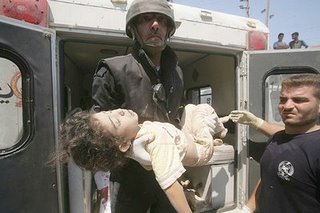 For all his trouble, the "Man in black" is at least rewarded - he gets to pose with one of the bodies discarded by the stars. A noble giant standing at the back of the ambulance, the tiny figure in his arms, there is a certain majesty and gravity to the man. Nevertheless, he clearly lacks the star quality, the ability to project raw emotion, a deficiency that condemns him to looking after the props after they have been discarded and playing the bit part after the stars have left the scene.
For all his trouble, the "Man in black" is at least rewarded - he gets to pose with one of the bodies discarded by the stars. A noble giant standing at the back of the ambulance, the tiny figure in his arms, there is a certain majesty and gravity to the man. Nevertheless, he clearly lacks the star quality, the ability to project raw emotion, a deficiency that condemns him to looking after the props after they have been discarded and playing the bit part after the stars have left the scene. Even then, one of the stars could not resist a repeat performance. It was obviously hot work running up and down the hill, and back up again, so off comes the trade-mark helmet, the radio, the flak jacket and the fluorescent waistcoat. "Green Helmet" au naturelle poses once more with his prop. But he is only going through the motions when it comes to projecting emotions and he lacks conviction.
Even then, one of the stars could not resist a repeat performance. It was obviously hot work running up and down the hill, and back up again, so off comes the trade-mark helmet, the radio, the flak jacket and the fluorescent waistcoat. "Green Helmet" au naturelle poses once more with his prop. But he is only going through the motions when it comes to projecting emotions and he lacks conviction. And at last the body of the poor mite that was once a pretty child is laid rest temporarily in the back of the ambulance. Even then, her mortal remains are publicity fodder, providing a poignant reminder of the tragedy, without the artifice of poses. This is the only natural pose in the whole sequence, but it lacks the drama the editors need. The picture ends up as a filler for internet archives.
And at last the body of the poor mite that was once a pretty child is laid rest temporarily in the back of the ambulance. Even then, her mortal remains are publicity fodder, providing a poignant reminder of the tragedy, without the artifice of poses. This is the only natural pose in the whole sequence, but it lacks the drama the editors need. The picture ends up as a filler for internet archives.The man from Hezbolla?
 While the dead rest at last, we now see why "White Tee-shirt" was so anxious to get away. He has to return home to be interviewed by a France 2 reporter. He starts by showing the reporter round the house, well furnished and far from modest. This is no poverty-stricken man, embittered by deprivation. Even by European or American standards, the house is comfortable.
While the dead rest at last, we now see why "White Tee-shirt" was so anxious to get away. He has to return home to be interviewed by a France 2 reporter. He starts by showing the reporter round the house, well furnished and far from modest. This is no poverty-stricken man, embittered by deprivation. Even by European or American standards, the house is comfortable. But what is so evident are the pictures of Sheik Hassan Nasrallah - even a calendar. This is not a dwelling - it is a shrine to Hezbolla, the party of God. But "White Tee-shirt" is not Hezbolla, oh, no! That is what he tells the young reporter, saying that it is the Israeli aggression that is radicalising Muslims and driving them into the arms of Hezbolla.
But what is so evident are the pictures of Sheik Hassan Nasrallah - even a calendar. This is not a dwelling - it is a shrine to Hezbolla, the party of God. But "White Tee-shirt" is not Hezbolla, oh, no! That is what he tells the young reporter, saying that it is the Israeli aggression that is radicalising Muslims and driving them into the arms of Hezbolla. Make up your own mind. Is this a Hezbolla member, or a mere supporter? He lives in a Hezbolla stronghold, a location from which the IDF claim over 150 missiles have been fired. And our "White Tee-shirt" has a house full of Hezbollah material and is not a member - was not all day driving that agenda forward? Was he simply an ordinary Joe, overcome with emotion at the death and destruction around him, of which he was entirely innocent?
Make up your own mind. Is this a Hezbolla member, or a mere supporter? He lives in a Hezbolla stronghold, a location from which the IDF claim over 150 missiles have been fired. And our "White Tee-shirt" has a house full of Hezbollah material and is not a member - was not all day driving that agenda forward? Was he simply an ordinary Joe, overcome with emotion at the death and destruction around him, of which he was entirely innocent? As a coda, we then see "White Tee-shirt" at Tyre hospital, in front of the now packaged bodies. He has finally changed his tee-shirt but is unmistakably the same man. The photograph, taken by AP's Mohammed Zaatari, is labelled, in part: "A Lebanese man, comforted by a Lebanese rescuer, cries in front of the body of his son who was recovered from under the rubble of a demolished building that was struck by Israeli warplane missiles at the village of Qana...".
As a coda, we then see "White Tee-shirt" at Tyre hospital, in front of the now packaged bodies. He has finally changed his tee-shirt but is unmistakably the same man. The photograph, taken by AP's Mohammed Zaatari, is labelled, in part: "A Lebanese man, comforted by a Lebanese rescuer, cries in front of the body of his son who was recovered from under the rubble of a demolished building that was struck by Israeli warplane missiles at the village of Qana...".back to the contents page
COMMENT THREAD
No comments:
Post a Comment
Note: only a member of this blog may post a comment.